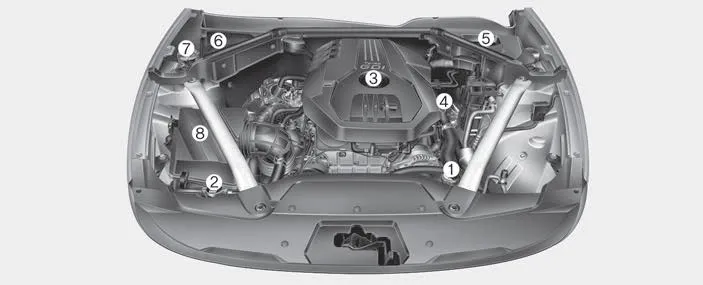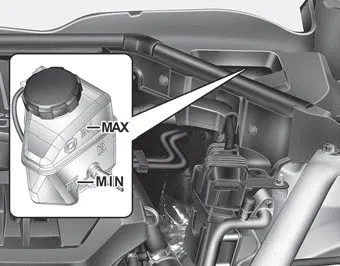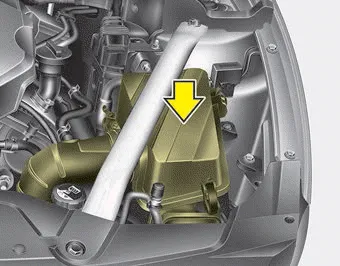Kia Stinger CK: Maintenance
Contents:
- Engine compartment
- Maintenance services
- Owner maintenance
- Scheduled maintenance service
- Explanation of scheduled maintenance items
- Checking fluid levels
- Engine oil
- Engine coolant
- Brake fluid
- Washer fluid
- Parking brake
- Air cleaner
- Climate control air filter
- Wiper blades
- Battery
- Tires and wheels
- Fuses
- Light bulbs
- Light bulb position (Side)
- Appearance care
- Emission control system
Engine compartment

■ THETA II 2.0L T-GDI Engine (Gasoline)

■ Lambda II PE 3.3L T-GDI Engine (Gasoline)
1. Engine coolant reservoir
2. Radiator cap
3. Engine oil filler cap
4. Engine oil dipstick
5. Brake fluid reservoir
6. Fuse box
7. Windshield washer fluid reservoir
8. Air cleaner
Maintenance services ➤
Owner maintenance ➤
Scheduled maintenance service ➤
Explanation of scheduled maintenance items ➤
Checking fluid levels
When checking engine oil, engine coolant, brake fluid, and washer fluid, always be sure to clean the area around any filler plug, drain plug, or dipstick before checking or draining any lubricant or fluid. This is especially important in dusty or sandy areas and when the vehicle is used on unpaved roads. Cleaning the plug and dipstick areas will prevent dirt and grit from entering the engine and other mechanisms that could be damaged.
Engine oil ➤
Engine coolant ➤
Brake fluid
Checking the brake fluid level

Check the fluid level in the reservoir periodically. The fluid level should be between MAX (Maximum) and MIN (Minimum) marks on the side of the reservoir.
Before removing the reservoir cap and adding brake fluid, clean the area around the reservoir cap thoroughly to prevent brake fluid contamination.
CAUTION - Proper fluid
Only use brake fluid in brake system. Small amounts of improper fluids (such as engine oil) can cause damage to the brake system.
If the level is low, add fluid to the MAX (Maximum) level. The level will fall with accumulated mileage. This is a normal condition associated with the wear of brake linings. If the fluid level is excessively low, have the brake system checked by an authorized Kia dealer.
Use only the specified brake fluid. (Refer to “Recommended lubricants and capacities” in chapter 8.)
Never mix different types of fluid.
In the event the brake system requires frequent additions of fluid, the vehicle should be inspected by an authorized Kia dealer.
When changing and adding brake fluid, handle it carefully. Do not let it come in contact with your eyes. If brake fluid should come in contact with your eyes, immediately flush them with a large quantity of fresh tap water. Have your eyes examined by a doctor as soon as possible.
CAUTION - Brake fluid
Do not allow brake fluid to contact the vehicle's body paint, as paint damage will result.
Brake fluid, which has been exposed to open air for an extended time should never be used as its quality cannot be guaranteed. It should be disposed of properly.
Washer fluid
Checking the washer fluid level

The reservoir is translucent so that you can check the level with a quick visual inspection.
Check the fluid level in the washer fluid reservoir and add fluid if necessary. Plain water may be used if washer fluid is not available. However, use washer solvent with antifreeze characteristics in cold climates to prevent freezing.
WARNING - Flammable fluid
Do not allow the washer fluid to come in contact with open flames or sparks.The windshield washer fluid reservoir is flammable under certain circumstances. This can result in a fire.
WARNING - Coolant
- Do not use radiator coolant or antifreeze in the washer fluid reservoir.
- Radiator coolant can severely obscure visibility when sprayed on the windshield and may cause loss of vehicle control.
WARNING - Windshield fluid
Do not drink the windshield washer fluid. The windshield washer fluid is poisonous to humans and animals.
Parking brake
Checking the parking brake

Check whether the stroke is within specification when the parking brake pedal is depressed with 20 kg (44 lbs, 196 N) of force. Also, the parking brake alone should securely hold the vehicle on a fairly steep grade. If the stroke is more or less than specified, have the parking brake adjusted by an authorized Kia dealer.
Stroke : 3 notch
Air cleaner
Filter replacement

■ THETA II 2.0L T-GDI Engine (Gasoline)

■ Lambda II PE 3.3L T-GDI Engine (Gasoline) (Passenger side)
The air filter must be replaced when necessary, and should not be washed.
Have the air cleaner filter inspected or replaced by an authorized Kia dealer.

■ Lambda II PE 3.3L T-GDI Engine (Gasoline) (Driver side)
Replace the filter according to the Maintenance Schedule.
If the vehicle is operated in extremely dusty or sandy areas, replace the element more often than the usual recommended intervals. (Refer to “Maintenance under severe usage conditions” in this chapter.)
CAUTION - Air filter maintenance
- Do not drive with the air cleaner removed; this will result in excessive engine wear.
- When removing the air cleaner filter, be careful that dust or dirt does not enter the air intake, or damage may result.
- Use a Kia genuine part. Use of a non-genuine part could damage the air flow sensor.
Climate control air filter
Filter inspection
The climate control air filter should be replaced according to the Maintenance Schedule. If the vehicle is operated in severely air-polluted cities or on dusty rough roads for a long period, it should be inspected more frequently and replaced earlier. When you replace the climate control air filter, replace it performing the following procedure, and be careful to avoid damaging other components.

1. Open the glove box and remove the stoppers on both sides.

2. With the glove box open, pull the support strap (1).

3. Remove the climate control air filter cover while pressing the lock on the left side of the cover.

4. Replace the climate control air filter.
5. Reassemble in the reverse order of disassembly.
When replacing the climate control air filter install it properly. Otherwise, the system may produce noise and the effectiveness of the filter may be reduced.
Wiper blades ➤
Battery ➤
Tires and wheels ➤
Fuses ➤
Light bulbs ➤
Light bulb position (Side) ➤
Appearance care ➤
Emission control system ➤
Other information:
Before entering vehicle Be sure that all windows, outside mirror(s), and outside lights are clean. Check the condition of the tires. Check under the vehicle for any sign of leaks. Be sure there are no obstacles behind you if you intend to back up. Necessary inspections Fluid levels, such as engine oil, engine coolant, brake fluid, and washer fluid should be checked on a regular basis, at the exact interval depending on the fluid.Battery saver function The purpose of this feature is to prevent the battery from being discharged if the lights are left in the ON position. The system automatically shuts off the parking lights 30 seconds after the ignition key is removed and the driver’s door is opened and closed. With this feature, the parking lights will turn off automatically if the driver parks on the side of the road at night and opens the driver’s side door.Categories
- Manuals Home
- Kia Stinger Owners Manual
- Kia Stinger Service Manual
- Engine compartment
- Maintenance services
- Owner maintenance
- Scheduled maintenance service
- Explanation of scheduled maintenance items
- Checking fluid levels
- Engine oil
- Engine coolant
- Brake fluid
- Washer fluid
- Parking brake
- Air cleaner
- Climate control air filter
- Wiper blades
- Battery
- Tires and wheels
- Fuses
- Light bulbs
- Light bulb position (Side)
- Appearance care
- Emission control system
- New on site
- Most important about car


